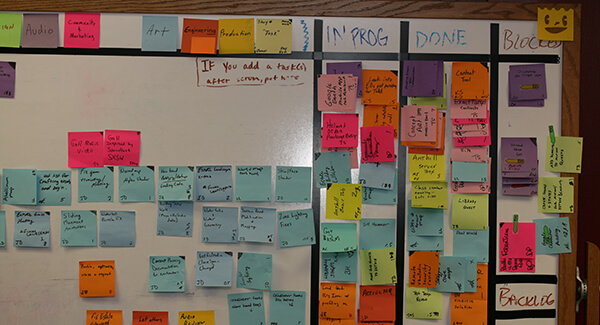Many Agile, Scrum, and Kanban followers do not recommend using a tool. At least at the beginning – they say, meaning that there are enough changes when adopting a new way of working and starting using a tool would make things even more difficult or even lead to failure. Also, they usually add that software is more complex and you have to work with it instead of doing real work. However, I would like to disagree. Conventional Scrum or Kanban boards may seem very simple at first sight and not so easy to manage when you really try do make it work for your team.
Physical task boards
- Scrum and Kanban task boards bring visibility.
- All the tasks are placed in corresponding columns, what makes an overview of the current situation – what is planned, what is the status of tasks that are being worked on, and what is already completed.
- The configuration of the task board is very flexible and easy to adapt to any team.
These statements are really attractive, so you get excited about how easy it can be to improve. You get some tape, markers, sticky notes and start with your Scrum or Kanban board. And here is where your illusions about flexible configuration and transparency of a physical board fade away.
Scrum board
Although a traditional Scrum board has only three columns – To do, Doing, Done – you may need to split DOING into more columns to show more specific stages a task goes through. Task cards contain quite a big amount of information – title, description, priority, estimation, assignment – so you need to make the columns big enough to contain several tasks at once. For this reason, you need quite a big whiteboard. And this leads to the result – instead of bringing visibility into the process, a big Scrum board with many tasks cards becomes just a big colourful wall which is difficult to understand.
Of course, you may not face all these troubles on the first day or week. It is more likely that you will start with a simple task board and everything will work well at the beginning. But later on, you will face the need to improve the task board, or your team will grow. And then you‘ll see that a Scrum board is not the best solution.
Here is how your Scrum board will look. No matter how hard you try to keep the physical board neat and tidy, those hand filled task cards still remind a colourful decoration. This Scrum board surely enlivens the team’s room, but I do it really perform its intended purpose?
Kanban board
- Visualized workflow helps identify bottlenecks.
- Prioritized Backlog ensures that the most important tasks are taken first.
- Work in progress limits prevent multitasking.
- Any team may adapt it to its own process.
All that is said really inspires you to start using Kanban as it is so simple and flexible that ay team may find a way to manage its projects following Kanban. And once again – all the shiny cover hides problems you face if your team has more than 5 members if you realize that each project you are working on has a different workflow. If two teams work on different projects, they need separate Kanban boards and this turns your office into a colourful disaster I think there is no need repeating that changing the layout of your physical Kanban board will not be very easy and you will probably try to avoid this.
Lets take the example of quite a simple Kanban bord which Arel English used while getting prepared for the summer season with sailing comunnity in Shelter Island, NY. He tells about his successful Kanban implementation in his blog.
Just look at those sticky notes in the Queue. It is good to know that they managed to put almost all of them to Done! But I think this was quite a big issue as there is no possibility to prioritize those tasks or see them at least.
Controversial thoughts arise after pointing out the pros and cons of physical task boards:
- People receive more than 80% of information using the sense of sight. However, combining several senses, for example, touch and sight helps to perceive information even better. This explains the great success and efficiency of Scrum and Kanban boards – they both show the process visually and lets team members feel that a task really goes through the process.
- Physical task board take time to manage them. Time is money. So we should not afford spending time on managing the physician Kanban or Scrum board when this can be done faster and even more efficient using Kanban and Scrum software.
Scrum or Kanban software
Even though it is advised not to use Agile software at the beginning, most likely you will decide to use it later anyway. At this point, I would say that adopting a tool when you start prevents you from one more transition later.
And what is most important – everything is much simpler when using a tool:
- Try different board templates to see which one works best for you without removing the tape from the whiteboard or redrawing columns and rows each time.
- Add as much info as needed to the task card, even attach files and still keep the board uncluttered.
- Filter tasks by team members, projects or types – see only what you need.
- Forget about drawing Burndown chart or drawing dots on the task cards to count its Lead time – Scrum and Kanban tools offer various reporting options which are very useful for progress evaluation, diagnosing of problems and future work planning.So, what do you prefer? Physical or electronic task boards?






